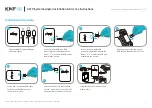
SAS BIOS configuration utility 9
SAS BIOS configuration utility
In this section
SAS BIOS features.................................................................................................................................... 9
Starting the SAS BIOS configuration utility................................................................................................... 9
Configuration utility screens..................................................................................................................... 10
Performing configuration tasks ................................................................................................................. 17
SAS BIOS features
The SAS BIOS is the bootable ROM code that manages SAS hardware resources. It is specific to a family
of SAS controllers and processors. The SAS BIOS integrates with a standard system BIOS, extending the
standard disk-service routine provided through INT13h.
During initialization, the SAS BIOS determines if the system BIOS has already installed other hard disks,
such as an IDE drive. If other drives are already installed, the SAS BIOS maps any SAS or SATA drives it
finds behind these drives. Otherwise, the SAS BIOS installs drives starting with the system boot drive, and
then the system boots from a drive controlled by the SAS BIOS.
The SAS BIOS supports the BIOS boot specification (BBS). If the system supports the BBS, use the system
BIOS setup menu to select the boot order and drive order. In the system BIOS setup, the Boot Connection
Devices menu lists the available boot options. Select the device and boot order. Exit to continue the boot
process.
Starting the SAS BIOS configuration utility
SAS BIOS 6.xx, with the SAS BIOS configuration utility, enables you to change the default configuration
of SAS host adapters. The default configuration might need to be changed if the adapter conflicts with
other devices or if system performance needs optimization.
The version number of the SAS BIOS appears during boot. If the configuration utility is available, the
following message also appears:
Press F8 to start LSI Logic Configuration Utility...
The exact key sequence required to start the utility might vary for different versions of the utility.
This message remains on the screen for 5 seconds, giving you time to start the utility. If you start the utility,
the screen displays the following message:
Please wait, invoking LSI Logic Configuration Utility...
After a pause, the SAS BIOS configuration utility opens.
The following messages might appear during the boot process:
•
Adapter removed from boot order!
This message appears when an adapter was removed from the system or was relocated behind a
PCI bridge.
•
Adapter configuration may have changed, reconfiguration is suggested!










































